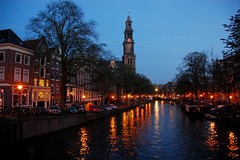I am traveling in style this morning, on a 1st ticket from Brussels to Amsterdam, an opportune result of booking early with Thalys online. I settle into an extra wide seat, log in to the free wifi onboard, and await any other unexpected and delightful amenities that might come my way.
To my initial chagrin, however, there is a group of loud Australians just across the aisle. There are four of them in facing seats and on the table between there are countless miniature bottles of alcohol.
So, they’re clearly drunk Australians. Great.
One of them pulls out a laptop to make a video call on Skype to a friend back home, but it doesn’t seem to work well. Yelling into the microphone, he says: “You’re frozen, Bill. Gee, you don’t look good frozen.” They are far too rowdy and obnoxious for their age, and yet against my better judgment I find that I’m actually beginning to like these guys. That is, until the conductor makes a sudden interruption in Antwerp. I sit anxiously through the trilingual announcement, only to discover amidst a clamor of angry voices and heaving suitcases that we’ve all been ordered off the train.
Over the past few years, I’ve been to France and Italy, all the while speaking very little French and Italian. My strategy has been a practical one. It is to concentrate on the essentials, to know the polite words that lubricate the gears of travel in a foreign land. Bon jour and buon giorno. S’il vous plait and per favore. Merci, madame and grazie, signore. For this trip, I listened to and rehearsed the basics in Dutch. Goeiedag, alstublieft, and dank u wel. But nothing has prepared me for this. I am drowning in a language I do not understand, hoping for an explanation, and straining to follow the complicated instructions I’ve been given.
Here is what I am able to piece together: There is a signal problem on the track ahead. The high-speed Thalys train I was on is scheduled to return to Paris later in the day, and in fear it will be late, it has been sent back to accommodate other passengers at our expense. Abandoned on a platform in Antwerp, we are given a set of options. We can wait here for a slower, regional train that will continue to Amsterdam if and when the problem on the track is resolved. Or, there is a train on Platform 6 leaving immediately that will take us to Kapellen, or Kessel, or some other town with a K-sound—I’m beginning to lose a grip on the details. From there we can catch a bus to Essen, and then yet another train to Amsterdam.
The mutinous passengers around me scatter, and for a moment I hesitate, feeling the weight of solo travel more than I ever have before. I decide to stay put and hope for the best. By now it’s well past lunch, and my stomach is growling, but it’s not clear when the train will move, so I can’t chance walking away to grab a sandwich. Nor is there food available onboard. When we depart at last, that much becomes clear. The 1st class ticket I purchased on a high-speed train has been converted into a slow and rather dirty means of transport.
I think again about the kind conductor I met outside of Ghent. “Don’t worry,” he said, “you’ll get there in the end.” I suppose it’s still true, but at the moment I can’t seem to rally my mood beyond a limited stoicism.
I do, in fact, get there in the end, but a bit worse for wear and definitely hungry. It’s 5:30 PM by the time we arrive at Amsterdam Centraal Station and I haven’t eaten since breakfast. The journey from Brussels was to have taken an easy two and a half hours, but it was a grueling five and a half in the end.
I take a cab to The Toren, a charming hotel that faces the Keizersgracht canal, and rush through check-in with the hope of begging someone at the Anne Frank House to let me in. Weeks ago, I had made a reservation online for 4:30 PM, thinking I had two hours of leeway, but my appointment time has come and gone and the fine print on my confirmation e-mail warns that my purchase is non-transferrable and non-refundable.
I rush around the corner to find that the line to buy tickets is still outrageously long at this late hour, stretching down the street towards Westerkerk, but I enter through a fast-lane door instead and present my expired reservation to the clerk, ready and almost eager to unburden myself of the day’s events. She glances down, then up at my face, and seems to grasp all that I feel.
And then she smiles.
It’s not a problem, she says. I can go straight in. She hopes I enjoy my visit.
There is a song by Joe Purdy that I like called “I’ve Been to Holland.” With a driving beat, he sings:
I don’t speak the language,
And all of the anguish,
It causes me to ask twice.
I don’t know much,
But know that I love the Dutch,
‘Cause they don’t have to try to be nice.
I exhale then, and feel the tension of the day melt away. In the mad rush here, I’ve hardly had the time register my surroundings. It occurs to me that I’ve been to Holland now, too, and nice can’t begin to describe it.
My visit through the Anne Frank house is all I had hoped it would be, and the gravity of the surroundings soon sets my mind straight on the absurdity of the day’s frustrations. The bookcase hiding the staircase to the Secret Annex is still there, as are the magazine clippings Anne glued to the wall in her room, including a photo of a young Princess Elizabeth of England. On the wall of the dining room there is a map of Normandy that Otto Frank used to track the advance of Allied troops. I stop and think about my visit to Omaha Beach and the American Cemetery and am struck by the sad end of that chain of events for Anne and her family, the van Pels, and Fritz Pfeffer. It was help that never came. Following their betrayal and arrest in August 1944, all but Otto died at the hands of the Nazis. Anne herself succumbed to typhoid at Bergen-Belsen, within days of the death of her sister Margot, and just weeks before the camp was liberated by the Allies at last.
I stare at Anne’s diary with its red gingham cover and tiny Dutch script, then at a quotation on the wall:
Perhaps it had to be that this one Anne Frank moves us more than all the other countless victims whose names remain unknown. If we had to share, and could share, the suffering of each one of them, we should be unable to go on living.
When I make my way back out onto the street, I find that the night has grown pleasantly cool. I settle on a causal dinner at De Prins, a traditional brown café just down the street on the Prinsengracht canal, where I feast on an Indian wrap made with chicken, lentils, spinach, cumin, madras curry, cashew nuts, and mint yoghurt.
By the time I leave, the street lights are starting to reflect into the waters of the canal and small bulbs are springing to life along the archways of the city’s bridges. Amsterdam is beautiful at night, and in spite of all, I am glad I came.





















